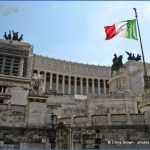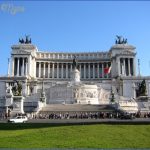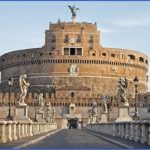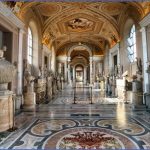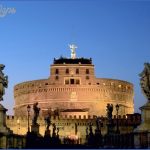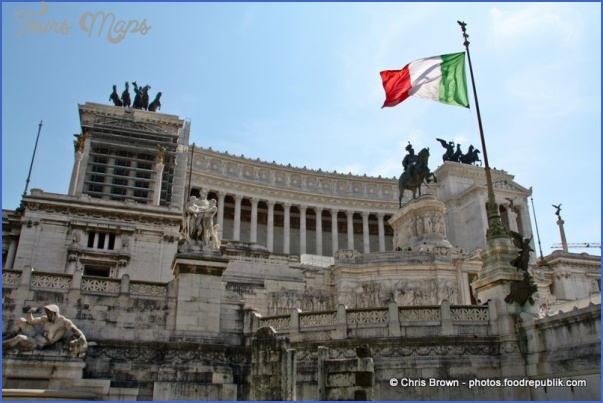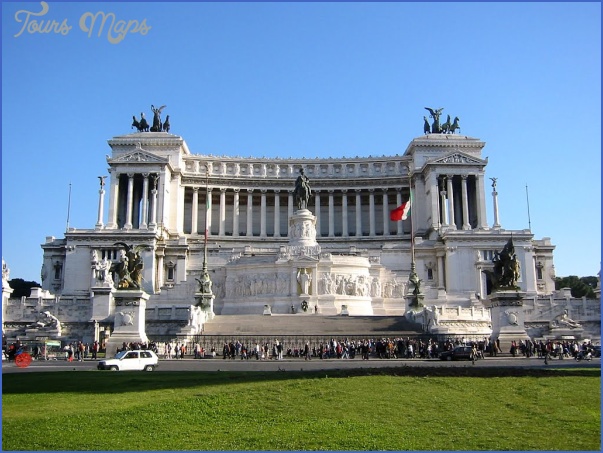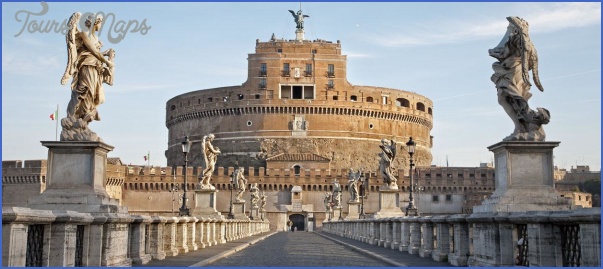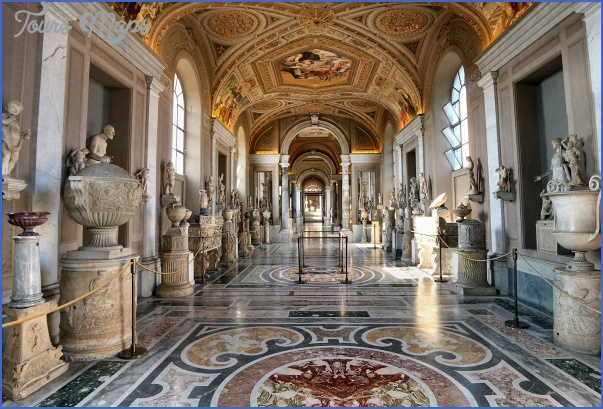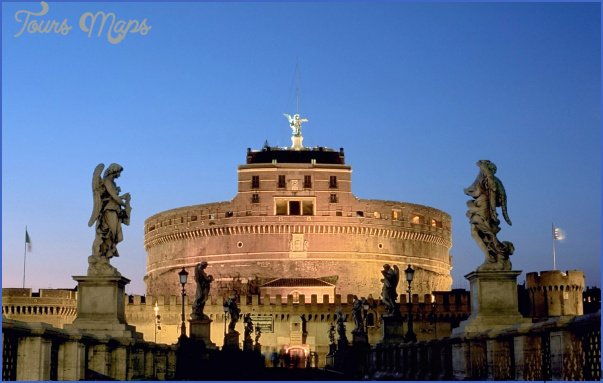ROME MUSEUMS
VATICAN MUSEUMS. More or less the content of every art book you’ve ever seen. The Vatican Museums constitute one of the world’s greatest collections of art, with ancient, Renaissance, and modem statues, painting, and papal odds and ends. The museum entrance at V. Vaticano leads to the famous bronze double-helix ramp that climbs to the ticket office. A good place to start a tour is the stellar Museo Pio-Clementino, the world’s greatest collection of antique sculpture. Two slobbering Molossian hounds guard the entrance to the Stanza degli Animali. a marble menagerie that highlights Roman brutality. Among other gems are the it’Apollo Belvedere and the unhappy Laocoon family. The last room of the gallery contains the enormous red sarcophagus of Sant’Elena, Constantine’s mother. From here, the Simonetti Stairway climbs to the Museo Etrusco, filled with artifacts from Tuscany and northern Lazio. Back on the landing of the Simonetti Staircase is the Stanza della Biga (room of an ancient marble chariot) and the Galleria della Candelabra. The long trudge to the Sistine Chapel begins here, passing through the Galleria degli Arazzi (tapestries), the Galleria delle Mappe (maps), the Aparta- mento di Pio V (where there is a shortcut to la Sistina, for all the cheaters out there), the Stanza Sobieski, and the Stanza della Immaculata Concezione. From the Room of the Immaculate Conception, a door leads into the first of the four iiStanze di Rafaele, apartments built for Pope Julius II in the 1510s. One stanza features Raphael’s School of Athens, painted as a trial piece for Julius, who was so impressed that he fired his other painters, had their frescoes destroyed, and com-missioned Raphael to decorate the entire suite. From here, there are two paths: a staircase leading to the brilliantly frescoed Borgia Apartments, the Museum of Modern Religious Art, and another route leading to the Sistine Chapel (649). On the way out of the Sistine Chapel, take a look at the Room of the Aldobrandini Marriage, which contains a series of rare, ancient Roman frescoes. Finally, the Vatican’s painting collection, the Pinacoteca, spans eight centuries and is one of the best in Rome. It includes Filippo Lippi’s Coronation of the Virgin, Perugino’s Madonna and Child, Titian’s Madonna of San Nicoletta dei Frari, and Raphael’s Transfiguration. (Walk north from P. S. Pietro along the wall of the Vatican City for about 10 blocks. s06 69 88 49 47. Open M-F8:45am-4:45pm, Sa 8:45am-l:45pm. Last entrance lhr. before closing. ‚10. Free last Su of the month 8:45am-l:45pm. Plan to spend at least 4-5hr.)
GALLERIA BORGHESE. The exquisite Galleria’s Room I, on the right, houses Canova’s sexy statue of Paolina Borghese portrayed as Venus triumphant. The next rooms display the most famous sculptures by Bernini: a magnificent David, crouching with his slingshot; Apollo and Daphne; the weightless body in Rape of Proserpina; and weary-looking Aeneas in Eneo e Anchise. Don’t miss six Caravaggio paintings, including his Self Portrait as Bacchus and St. Jerome, which grace the side walls. The collection continues in the pinacoteca upstairs, accessible from the gardens around the back by a winding staircase. Room IX holds Raphael’s Deposition while Sodoma’s Pieta graces Room XII. Look for self portraits by Bernini, del Conte’s Cleopatra and Lucrezia, Rubens’s Pianto sul Cristo Morto, and Titian’s Amor Sacro e Amor Profano. CM: A-Spagna; take the exit labeled Villa Borghese,” walk to the right past the Metro stop to V. Muro Torto and then to P. Porta Pinciana; Viale del Museo Borghese is ahead and leads to the museum. Open daily 9am-7pm. Entrance every hr. visits limited to 2hr. Tickets (including reservation, tour, and bag charge) ‚8. Audio guide ‚5. Open M-F 9am-6pm, Sa 9am-lpm.)
CAPITOLINE MUSEUM. This collection of ancient sculpture is one the largest in the world. The Palazzo Nuovo contains the original statue of Marcus Aurelius that once stood in the center of the piazza. The collections continue across the piazza in the Palazzo dei Conservatori. See fragments of the Colossus of Constantine and the famous Capitoline Wolf, an Etruscan statue that has symbolized the city of Rome since antiquity. At the top of the stairs, the pinacoteca’s masterpieces include Bellini’s Portrait of a Young Man, Titan’s Baptism of Christ, Rubens’s Romulus and Remus Fed by the Wolf, and Caravaggio’s St. John the Baptist and Gypsy Fortune-Teller. (On Capitoline Hill behind the Vittorio Emanuele II monument. 06 399 6 78 00. Open Su and Tu-Sa 9am-8pm. ‚7.80. Guidebook ‚7.75, audio guide ‚4. Guided tours in Italian Sa 5pm, Su at noon and 5pm.)
MUSEO NAZIONALE D’ARTE ANTICA. This collection of 12th- through 18th-century art is split between Palazzo Barberini and Palazzo Corsini, in different parts of the city. Palazzo Barberini contains paintings from the medieval through Baroque periods, including works by Lippi, Raphael, El Greco, Carracci, Caravaggio, and Poussin. Galleria Corsini holds a collection of 17th- and 18th-century paintings, from Dutch masters Van Dyck and Rubens to Italians Caravaggio and Carracci. (Palazzo Barperini: V. delle Quattro Fontane, 13. M: A-Barberini. Bus #492 or 62. s 06 420 036 69. Open Tu-Su 9am-7:30pm. ‚6. Galleria Corsini: V. della Lungara, 10. Opposite Villa Famesina in Trastevere. Take the #23 bus and get off between Ponte Mazinni and Ponte Sisto. 06 688 023 23. Open Su and Tu-Sa 8:30am-7:30pm. ‚4. Wheelchair-accessible.)
VILLA FARNESINA. The Villa was the sumptuous home to Europe’s one-time wealthiest man, Agostino il Magniflco Chigi. To the right of the entrance lies the breathtaking Sala of Galatea, mostly painted by the villa’s architect, Baldassare Peruzzi, in 1511. The vault displays symbols of astrological signs that add up to a symbolic plan of the stars at 9:30pm on November 29, 1466, the moment of Agos- tino’s birth. The masterpiece of the room is Raphael’s Triumph of Galatea. The stucco-ceilinged stairway, with its gorgeous perspective detail, ascends to the Loggia di Psiche, for which Raphael received the commission. The Stanza delle Prospet- tive, a fantasy room decorated by Peruzzi, offers views of Rome between trompe Voeil columns. The adjacent bedroom, known as the Stanza delle Nozze (Marriage Room), is the real reason for coming here. H Sodoma, who had previously been busy painting the pope’s rooms in the Vatican, frescoed this chamber until Raphael showed up and stole the job. D Sodoma bounced back, making this masterful fresco of Alexander the Great’s marriage to the beautiful Roxanne. (Acrass from Palazzo Corsini on Lun- gotevere Famesina. Bus #23; get off between Ponte Mazinni and Ponte Sisto. At V. della Lungara, 230. 06 6802 7268. Open M-Sa 9am-lpm. ‚4.50, under-18 ‚3.50.)
GALLERIA SPADA. Cardinal Bernardino Spada bought a grandiose assortment of paintings and sculpture and commissioned an even more opulent set of great rooms to house them. Time and good luck have left the palatial 17th-century apartments nearly intact a visit to the gallery offers a glimpse of the luxury surrounding Baroque courtly life. In the first of the gallery’s four rooms, the modest cardinal hung portraits of himself by Guercino, Guido Reni, and Cerini. In Room 2, look for paintings by the Venetians Tintoretto and Titan and a frieze by Vaga, originally intended for the Sistine Chapel. In Room 4 are three canvases by the father-daughter team of Orazio and Artemisia Gentileschi. (From Campo dei Fiori, take any of the small streets leading to P. Farnese. Facing away from Campo dei Fiori, turn left on Capo di Ferro. Bus #64. P. Capo di Ferro, 13, in the Palazzo Spada. 06 687 48 96. Open Su 9am-7:30pm, Tu-Sa 8:30am-7:30pm. Last tickets 7pm. ‚5. Reservations ‚1 extra. Guidebooks ‚10.50. Guided tourSu 10:45am from museum bookshop. Pamphlet guides in English available for each room of the exhibit.)
MUSEI NAZIONALI ROMANI. The fascinating Museo Nazionale Romano Palazzo Massimo is devoted to the history of Roman art during the Empire, including the Lancellotti Discus Thrower and a rare mosaic of Nero’s. (Largo di V. Peretti 1. In the left-hand corner of P. dei Cinquecento. sO6 481 55 76. Open Su and Tu-Sa 9am-7:45pm; ticket office open Su and Tu-Sa 9am-7pm. ‚6. Audio guide ‚2.50.) Nearby, the Museo Nazionale Romano Terme di Diocleziano, a beautifully renovated complex partly housed in the huge Baths of Diocletian has exhibits devoted to ancient epigraphy (writing) and Latin history through the 6th century BC. (P. dei Cinquecento 78. Opposite Termini. s06 39 96 77 00 for reservations. Open Su and Tu-Sa 9am-7pm. ‚5. Audioguide ‚4; guided tour with archaeologist ‚3.50.) The Aula Ottogonale, another wing, holds 19 classical sculptures in a gorgeous octagonal space. (V. Romita 8. s 06 39 96 77 00. Open Tu-Sa 9am-2pm, Su 9am-lpm. Free.) Across town is the Renaissance man of the trio, Museo Nazionale Romano Palazzo Altemps, displaying Roman sculpture, including the famous 5th-century Ludovisi Throne. (P. Sant’Apollinare 44. Just north of P. Navona. Museum 06 783 35 66. Open Su and Tu-Sa, 9am-7pm. ‚5. Audioguide ‚4.)
EUR MUSEUMS. All of the museums splayed around Mussolini’s obelisk are small and manageable, and serve as a break from the usual decadent Classical and Renaissance offerings of Rome’s more popular museums. The intimidating facade of the Museo della Civilita Romana gives way to a number of scale models of life in ancient Rome. See how the Longobards overran the remains of the Empire in the Museo dell’Alto Medioevo, a collection of weapons, jewelry, and household items from Late Antiquity. The Museo Nazionale delle Arti e Tradizioni Popolari contains such incongruent items as a Camevale costume and a wine press. The skull of the famous Neanderthal Guattari Man, discovered near Cir- ceo, is found at the Museo Preistorico ed Etnografico Luigi Pigorini. (M: B-EUR- Palasport or B-EUR-Fermi. Walk north up V. Cristoforo Colombo. Civilita Romana: Open Tu-Sa 9am- 6:45pm, Su and holidays 9am-l:30pm. ‚6.20. Alto Medioevo: Open Tu-Su 9am-8pm. ‚2. Nazionale delle Arti e Tradizioni Popolari: Open Tu-Su 9am-8pm. Closed holidays. ‚4. Preistorico ed Etnografico Luigi Pigorini: Open daily 9am-8pm. ‚4. All museums: under-18 and over-65 free.)
OTHER RECOMMENDED COLLECTIONS. Montemartini, Rome’s first power plant, was converted to hold displaced sculpture from the Capitoline Museums in the 1990s. (V. Ostiense 106. M: B-Piramide. Open Su and Tu-Sa 9:30am-7pm. ‚4.20.) The Doria Pamphilj family, whose relations with Pope Innocent X spawned the term nepotism, still owns its stunning private collection. Titian’s Salome and Velasquez’s portrait of Innocent X alone are worth the visit. (P. del Collegio Romana 2. Open M-W and F-Su 10am-5pm. ‚7.30, students and seniors ‚5.70. Audioguide included.) After overdosing on artwork and culture, get your aesthetic stomach pumped at the one museum dedicated to crime and punishment, the Museo Criminologico. Etchings like A Smith Has His Brains Beaten Out With a Hammer hang on the walls along with terrorist, spy, and druggie paraphernalia (V. del Gonfalone 27. Open Tu-Th 9am-lpm and 2:306:30pm, F- Sa 9am-lpm. ‚2; under-18 and over-65 ‚1.) Despite its disorganization and limited hours, the Galleria Colonna remains impressive. The palazzo was designed in the 18th century to show off the Colonna family’s collection, including Tintoretto’s Narcissus. (V. della Pilotta 17. North of P. Venezia in the centra storico. 06 66 78 43 30. Open SeptMy Sa 9am-lpm. ‚7, students ‚5.50, over-65 free. Included tour 1 lam in Italian and 11:45am in English.) An eccentric, smallish museum, the Museo Mario Praz was the last home of Mario Praz (1896-1982), an equally eccentric and smallish professor of English literature and 18th- and 19th-century art collector. Superstitious neighbors spat or flipped coins when they saw him. (At the east end of Ponte Umberto, right next to Museo Napoleonico. V. Zanardeili 1, top fl. s06 686 10 89. Must visit museum with small tour groups (35-45min.) that leave every hr. in the morning and every half-hr. in the afternoon. Open M 2:306:30pm, Tu-Su 9am-lpm and 2:30-6:30pm. Free.)
ENTERTAINMENT
Unfortunately, Roman entertainment just ain’t what it used to be. Back in the day, you could swing by the Colosseum to watch a man get mauled by a bear; today, Romans seeking diversion are more likely to go to a nightclub than fight a wild beast to the death. Check Roma C’e (which has an English-language section) or Time Out, available at newsstands, for club, movie, and events listings.
ROME MUSEUMS Photo Gallery
Maybe You Like Them Too
- Explore Pulau Sebang Malaysia with this Detailed Map
- Explore Southgate, Michigan with this detailed map
- Explore Les Accates, France with this Detailed Map
- Explore Góra Kalwaria, Poland with this detailed map
- Explore Gumdag, Turkmenistan with this detailed map

